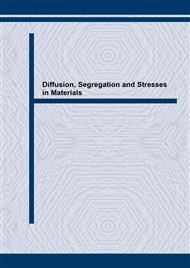[1]
W. Mullins: J. Appl. Phys. Vol. 28 (1957), p.333
Google Scholar
[2]
W. Mullins: J. Appl. Phys. Vol. 30 (1959), p.77
Google Scholar
[3]
W. Mullins: Trans. AIME Vol. 218 (1960), p.354
Google Scholar
[4]
G. Doetsch: Handbuch der Laplace Transformation, Bd.1-3 (Basel, Birkhanser 1956). Appendix Let us analyze characteristic Eq. 32 0 )1( 246 =�+�� ������ (A1) This equation has six complex roots, with only three of them having positive real part. Note, that of the roots �0, �1 and �2, the root �0 is real, �1, �2 are real or complex conjugate roots, depending on the values of parameters � and � (see Fig. 5a). To separate these parameter regions, note that on their boundaries �1 = �2 and, thus, Eq. A1 has a double root. It means � is also a root of derivative of Eq. A1 01213 2 4 =+�� ����)( (A2) Eliminating � from Eqs. A1 and A2 we obtain needed relations between � and �. Fig. 5 Map for the roots of characteristic equation The following procedure is used to calculate roots of Eq. A1. First, the real root, �0, is calculated recursively by rewriting Eq. A1 as 4 6 2 1 � �� �� + += (A3) Then, the roots �1, �2 are calculated from the quadratic equation (in � 2) ( ) 0 1 1 2 0 22 0 4 =+���� �������� /)()( (A4) obtained by factoring Eq. A1. Typical results of these calculations are shown in Fig. 5b. For limiting case � << 1: �� =0 , 2121 /)i(, ±=� , (A5) for case � << 1: 00 � , 211 41 21 /)i()( / , ±�= � �� , (A6) and for case � >> 1: )/( ��� �= 10 , 2121 /)i(, ±=� (A7) 0,0 0,5 1,0 1,5 2,0 -1,5 -1,0 -0,5 0,0 0,5 1,0 1,5 � = 0.95 � = 0.9 � = 0.8 � = 0.5 Im( �1,2 ) Re( �1,2 ) 0,0 0,5 1,0 1,5 0 1 2 3 4 �= 0.5 �= 0.8 �= 0.9 �= 0.95 �0 � Fig. 6 Real and complex conjugate roots �i versus parameter �
Google Scholar


